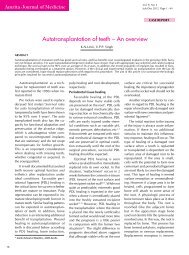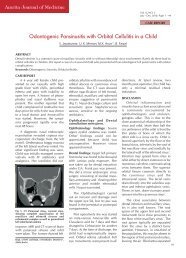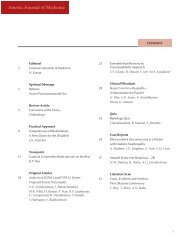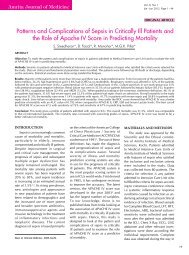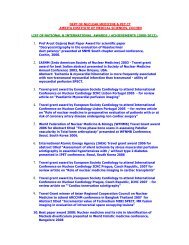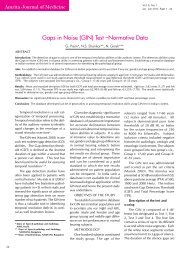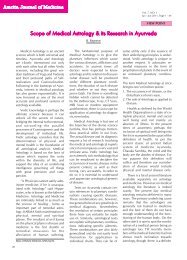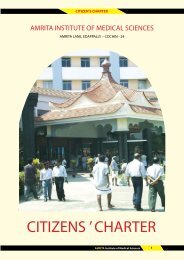Journal of Medicine Vol 2 - Amrita Institute of Medical Sciences and ...
Journal of Medicine Vol 2 - Amrita Institute of Medical Sciences and ...
Journal of Medicine Vol 2 - Amrita Institute of Medical Sciences and ...
You also want an ePaper? Increase the reach of your titles
YUMPU automatically turns print PDFs into web optimized ePapers that Google loves.
<strong>Amrita</strong> <strong>Journal</strong> <strong>of</strong> <strong>Medicine</strong><br />
Adhesive Felt Offloading in the Healing <strong>of</strong> Diabetic Foot Ulcers<br />
foot is in contact the last 59 percent <strong>of</strong> the phase. This<br />
means all <strong>of</strong> the body weight is on one heel or one forefoot<br />
a significant period <strong>of</strong> time. This pressure can equal<br />
1.2 to 1.5 times the body weight depending on the walking<br />
speed 5 .<br />
When a deformity is present, there is increased pressure<br />
on the foot. Researchers have shown that diabetes<br />
causes a decrease in conduction speed in the tibial <strong>and</strong><br />
peroneal nerves. This correlates to increased lower extremity<br />
muscle weakness. Muscle weakness may lead to<br />
foot deformity <strong>and</strong> subsequently cause areas <strong>of</strong> increased<br />
pressure 6 .<br />
With regard to <strong>of</strong>floading; some material is usually<br />
placed on the foot such as padding or dressings. However,<br />
the first <strong>and</strong> most important <strong>of</strong>floading technique<br />
is to actually take pressure <strong>of</strong>f from the skin <strong>of</strong> the plantar<br />
aspect <strong>of</strong> the foot. Debriding the hyperkeratotic skin<br />
surrounding the wound edge is the one aspect <strong>of</strong><br />
<strong>of</strong>floading that one should address 7,8 . When left untreated,<br />
the thick <strong>and</strong> callused edges <strong>of</strong> a wound will roll<br />
inward <strong>and</strong> inhibit the wound edges from migrating towards<br />
the center. This hyperkeratotic edge may also cause<br />
increased plantar pressure. Based upon Dr. Paul Br<strong>and</strong>’s<br />
work that demonstrated the greatest amount <strong>of</strong> pressure<br />
placed on a foot ulcer is at the leading edge, Armstrong<br />
<strong>and</strong> Athanasiou later coined the term “edge effect” 13,16 .<br />
One might think the greatest pressure would be in the<br />
center <strong>of</strong> the wound but many plantar ulcers have such<br />
significant depth that the weight bearing forces do not<br />
affect the center <strong>of</strong> the wound. Due to the natural<br />
<strong>of</strong>floading <strong>of</strong> the central wound cavity, plantar foot pressures<br />
intensify at the leading edge <strong>of</strong> the wound. This is<br />
why many plantar foot ulcers need weekly, or at least<br />
frequent, debridement for <strong>of</strong>floading purposes 9,15 .<br />
Gait modification <strong>of</strong>fers another simple means <strong>of</strong><br />
<strong>of</strong>floading the foot. A reduction in walking speed or shuffling-type<br />
gait can reduce the pressure on the forefoot.<br />
Unfortunately, it is sometimes difficult for patients to<br />
change their walking patterns abruptly. Physical medicine<br />
can be helpful in retraining patients in gait when<br />
needed. All attempts should be made to keep these patients<br />
ambulatory with the exception <strong>of</strong> large wounds.<br />
Continued ambulation can reduce other morbidity. <strong>Medical</strong><br />
grade adhesive felt is an excellent technique for<br />
ambulatory <strong>of</strong>floading <strong>of</strong> plantar ulcers in diabetic patients<br />
10, 11 .<br />
Felts are a class <strong>of</strong> fabrics or fibrous structures obtained<br />
through the interlocking <strong>of</strong> wool, fur, cotton, rayon<br />
or some hair fibers under conditions <strong>of</strong> heat, moisture,<br />
<strong>and</strong> pressure. With the exception <strong>of</strong> felt, nonwoven<br />
materials are in the early stages <strong>of</strong> development. Nonwoven<br />
fabrics can be defined as textile fabrics made <strong>of</strong> a<br />
Plate: 1<br />
A<br />
B<br />
C<br />
D<br />
A: Shows a forefoot plantar ulcer prior to starting felt <strong>of</strong>floading treatment. B: Shows felt pad applied around the<br />
ulcer. C: Shows healing ulcer after about 3 weeks <strong>of</strong> treatment. D: Shows epithelialised ulcer.<br />
28



